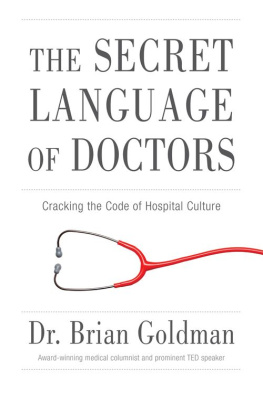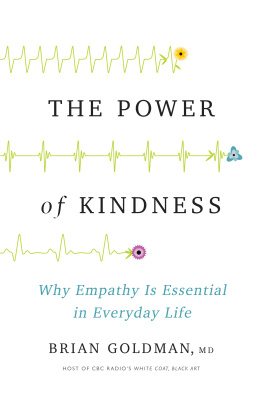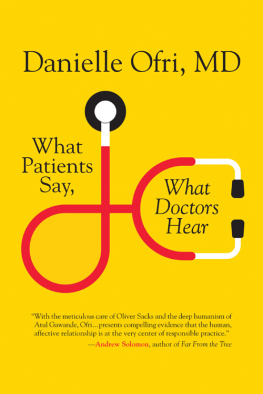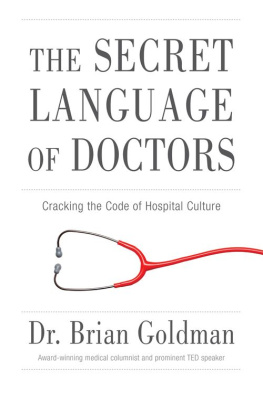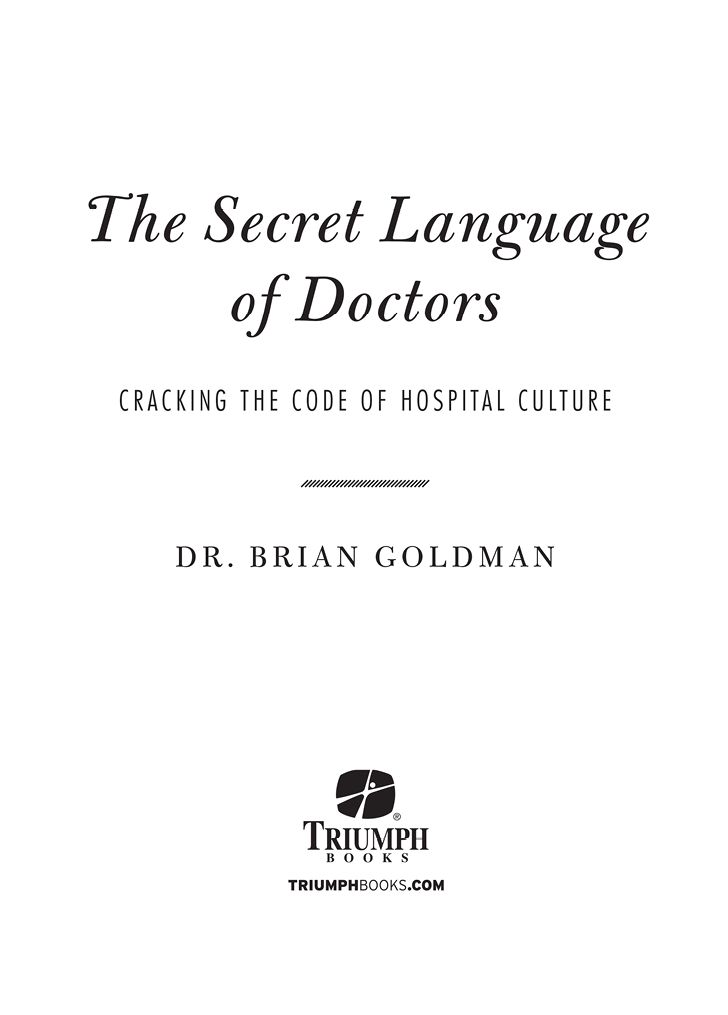
To my late father, Samuel, who died before he could read this book, and to my mother, Shirley, whose heart is in this book though shell never read it.
Contents
Copyright
Dedication
About the Author
About the Publisher
1. The Bunker
p.m. Handover
In a small, secluded room behind the nursing station of Ward 6 West, residents gather for the daily ritual called handover, or patient sign-out. Its the moment when the army of staff doing scheduled tests, interventions and operations shifts down to a skeleton crew of residents on call whose job is to monitor patients and attend to any sudden emergencies. Its also when residents who arent on call finally get to go home. But first, they have to give their colleagues the heads-up on every patient under their charge.
The rectangular room where they meet is nicknamed the Bunker. The room contains four cubicles equipped with computers, a printer and a coffee machine. A small sofa bed is off to one side. The walls blue paint is scuffed with furniture marks. In the middle of the room is a small conference table ringed with chairs.
The Bunker is where residents meet with the ward chiefthe attending or most senior physician in charge of the patientsto write up chart notes and to talk frankly about patients and fellow doctors who work on other floors and in other hospitals. The room, teeming with two sets of residentsthe ones on call and the ones handing overis hot and stuffy.
Room 22, bed B, 82-year-old male, says Rick, a first-year resident in internal medicine. Admitted ten days ago with a fractured pelvis. He also has moderate Alzheimers dementia, GERD and type 2 diabetes. OT and PT say its not safe for him to go home. Hes awaiting placement.
Whats his code status? asks Sandi, the senior resident on call.
Hes Full Code, answers Rick. We tried to get the DNR but the family said theyre thinking about it.
Thinking about it? repeats Sandi. Can we do a Hollywood Code?
Youre on call, so its your show, says Raza, the senior resident on Ricks team. But the family is there 24/7. I think theyd know it if you run a Slow Code.
You may hear about a consult we did on ortho, says Raza. Eighty-eight-year-old female five days post right total hip replacement. Post-op, she was overhydrated by the ortho resident and put into CHF. She had a bump in her troponin. Weve given her Lasix and shes feeling better. Shes stable now.
Saved another FOOBA, says Sandi.
Thats the third one this month, says Raza.
Next patient is Room 24, bed C, 58-year-old female, says Rick. Admitted over the weekend with type 1 diabetes and DKA triggered by a urinary tract infection. Unfortunately, she developed a pressure sore on her sacrum. Plastics is consulting on that.
Pressure ulcer? asks Sandi. How the hell does a 58-year-old diabetic get a pressure ulcer on her bum?
Shes a beemer, says Raza.
How big is she? asks Sandi.
Three clinic units, answers Raza. We tried using the Hoyer lift but it wasnt rated for her.
Sounds like a horrendoma, says Sandi.
It gets worse, says Rick. We dont have a bariatric commode or wheelchair to get her to the bathroom. She had a Code Brown in the bed.
Who got to clean that up? asks Sandi.
Thank god for LPNs, says Raza. Everybody in the room laughs.
* * *
The dialogue you just read was created to illustrate just how much medical jargon can be packed into a brief discussion.
The 82-year-old man has GERD, which stands for gastroesophageal reflux disease, better known as heartburn. The residents referred him to OT and PToccupational therapy and physiotherapy. Thats standard procedure for a patient with a cracked pelvis to determine whether the fracture will keep him from going home; an OT/PT assessment is also used to find out if a patient is likely to fall at home and what preventative safety measures might be necessary.
Razas 88-year-old patient on the orthopedic floor went into CHFcongestive heart failureafter the orthopedic resident gave her too much intravenous fluid. A bump in her troponin means the woman had a slight increase in the level of a protein called troponin, which indicates that she suffered a mild heart attack.
The 58-year-old woman was admitted to hospital with DKA, which stands for diabetic ketoacidosis, a life-threatening condition in which both the sugar and acid in the bloodstream rise to dangerous levels. A plastics consult means she was seen by a plastic surgeon, the specialist who usually manages skin ulcers.
But the residents also used a bunch of words and phrases that arent found in any medical textbook I know of, yet they were understood by everyone in the Bunker. If you sat in on that conversation, you might have thought youd wandered into a very boring French film. Now, lets provide the subtitlesstarting with the 82-year-old man.
- Hes awaiting placement means there are no ongoing medical issues and if he could go home safely, wed have sent him out by now.
- Whats his code status? means Do we have to do CPR (cardiopulmonary resuscitation) if his heart stops?
- Hes Full Code. We tried to get the DNR but the family said theyre thinking about it means the family wants him to be resuscitated if his heart stops. They cant see the handwriting on the wallthat theres no point in doing CPR if his heart stopsand they arent ready to sign a Do Not Resuscitate order.
- Can we do a Hollywood Code? means that if his heart stops well do a pretend resuscitation in which it looks as if were trying to save him but we arent.
Now, well take look at the acronym Sandi the resident used to talk about the patient on the orthopedic floor who was put into congestive heart failure. Saved another FOOBA means the internal medicine team saved another patient who was found on orthopedics barely alive. Its a dig at orthopedic surgeons, who have a reputation for being so focused on what needs to be fixed surgically that they ignore signs of other diseases. FOOBA is a play on FUBAR, a military slang term that has entered common vernacular and stands for fucked up beyond all repair.
Finally, lets unpack the slang that was used by the residents to talk about the 58-year-old woman in Room 24, bed C:
- How the hell does a 58-year-old diabetic get a pressure ulcer on her bum?Shes a beemer means the woman got a pressure ulcer on her buttocks because she has a high body mass index, or BMI, a polite way of saying that she is morbidly obese. In other words, shes so large that she developed a pressure ulcer from lying on her backside too long because she was too weak to move and she weighed too much for nurses to shift her position in bed.
- Three clinic units is a sneaky way of saying the patient weighs 600 pounds. One clinic unit refers to a weight of 200 pounds.
- Sounds like a horrendoma refers to a horrible or awful condition.
- We dont have a bariatric commode or wheelchair to get her to the bathroom. She had a Code Brown in the bed means that she is so large that when she had to defecate, several nurseswho didnt have special lifting equipmentcould not manage to move her to the bathroom or commode or even to place a bedpan underneath her, so she defecated in her bed.
- Thank god for LPNs refers to licensed practical nurses. Poop runs downhill. Residents can laugh about a Code Brown because they arent the ones who have to clean it up.
That is a crash course in the Secret Language of Doctors and what the language reveals about how these doctors view patients and their families in the culture of modern medicine.
* * *
Doctors share a culture that many hardly realize exists, much less talk about. In a 2008 paper published in the journal Academic Medicine , Dr. Carla Boutin-Foster and colleagues defined medical culture as the language, thought processes, styles of communication, customs, and beliefs that often characterize the profession of medicine.
Next page
